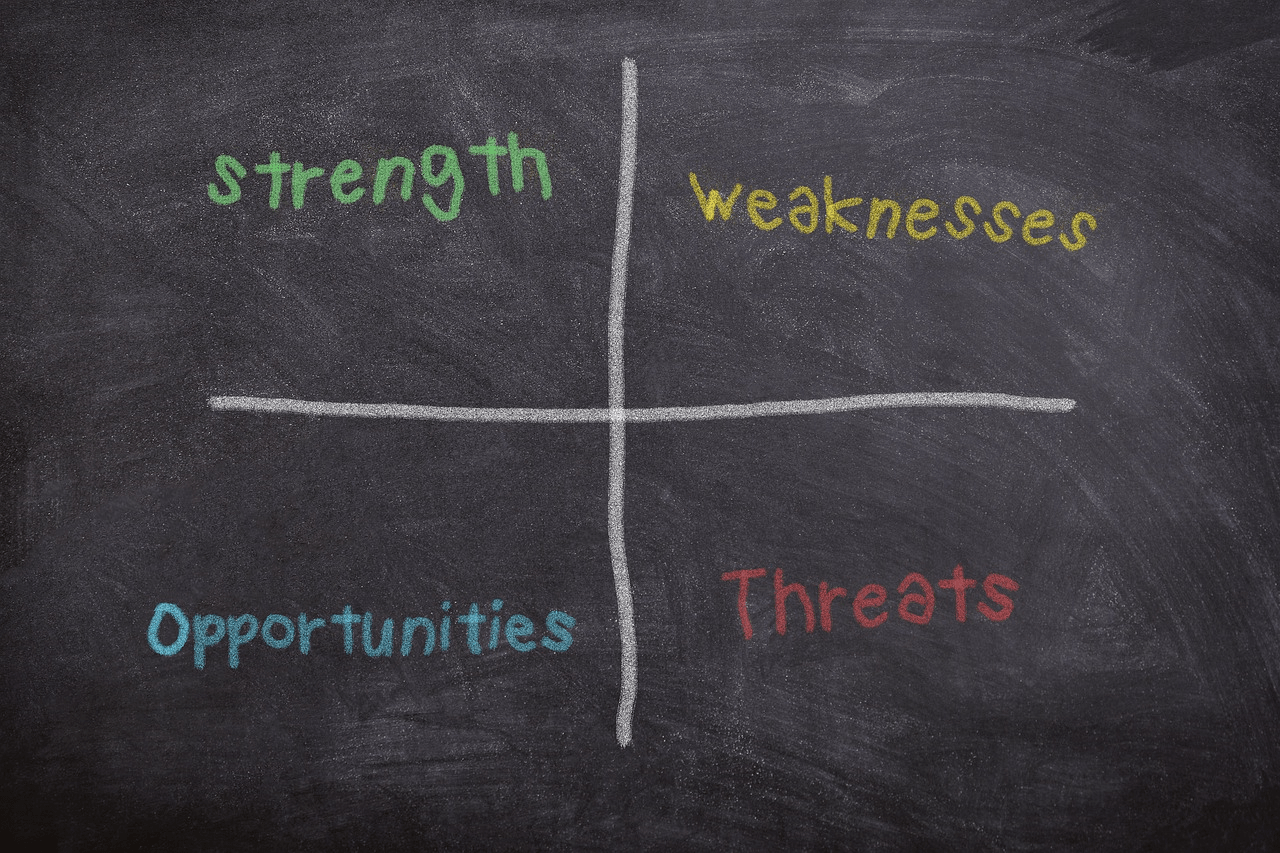A project SWOT analysis is a strategic planning technique that project managers can use to assess the strengths and weaknesses of their projects.
CONTENT
In addition, this analysis will allow for the identification of opportunities and threats that may need to be addressed during the project life cycle.
Incorporating SWOT analysis into project management can help improve planning, reduce risk, and increase overall project success.
What does SWOT mean?
A SWOT analysis is a technique that companies often use to evaluate four critical aspects of their organization.
This analysis can help companies better understand how successful they are likely to be and what areas they should improve.
Just as entrepreneurs and executives use a SWOT analysis to evaluate their company, project managers can use the same technique to assess their projects.
Here is an overview of the four areas of interest that make up the SWOT acronym and how they apply to project management:
- S – Strengths: These are internal factors, i.e., factors that can generally be controlled, that determine the success of a project. An example might be good project management software or experienced team members.
- W – Weaknesses: Weaknesses are internal factors that can make it difficult for a project to succeed. For example, when the team has never worked together, and several members are new and inexperienced. Other internal weaknesses could be disengaged stakeholders or lack of project funding.
- O – Opportunities: Opportunities are external, uncontrollable factors that could help the project succeed. These opportunities may be current but not yet exploited or future. An example might be a discount on goods from a supplier.
- T – Threats: These are external factors that could harm the project if they occur. As with opportunities, they can be current or future threats. For example, a threat could be the failure of a major supplier or customer, or increased costs of supplies, materials, or contractors.
What is the purpose of a SWOT analysis?
SWOT-analysis helps the project manager plan the project and considers the factors that can help or hinder its success.
In fact, the goal is to find risk areas and controllable factors that need to be paid attention to and monitored throughout the project.
When you fully understand a project’s strengths, weaknesses, opportunities, and threats, you can plan a successful strategy that addresses these four factors.
Conducting a SWOT analysis can help produce new ideas for leveraging what the project manager and team do best and potential opportunities.
In addition, SWOT analysis also helps increase awareness of weaknesses and potential threats to the project so that you can defend against them.
Who should do a SWOT analysis?
For a SWOT analysis to be effective, you need complete, accurate, and unbiased information.
Depending on the project’s scope, the team conducting the analysis should have a good overview of the organization and the business.
A project with a larger scope usually should involve a project leader with a higher position or an outside expert to perform the analysis.
In addition, a project with a greater impact on the entire company should involve multiple participants in different departments of the organization.
In general, creating a team with diverse perspectives is essential for a more accurate assessment.
Advantages of SWOT analysis
Companies should perform a SWOT analysis before committing to any action or project plan.
In this way, they can answer questions such as “is it possible to do the project?” or “should we do the project?”.
SWOT analysis provides teams and organizations with the following benefits:
- Create honest assessments of their strengths and weaknesses.
- Provides new perspectives on the company and its business.
- Provides information on how to maximize what is available, address limitations, make additional investments, and avoid risk.
- Create supporting documents for the project plan.
- Provides an effective strategic planning tool when performed regularly.
Examples of SWOT analysis
A medical startup wants to develop and commercialize a noninvasive, optically-based blood glucose monitor in this example.
This company wants to offer patients a better way to monitor and manage their blood sugar levels without painfully pricking their fingers using traditional home electronic glucose meters.
So, let’s see what the SWOT analysis looks like in this case.
Strengths:
- The company has patents on its optical blood glucose monitor technology.
- The technology and device are FDA approved.
- The company has the support of industry experts with extensive experience regarding technology, including medicine, optics, electronics, and manufacturing.
Weaknesses:
- The company has no funding.
- As a startup, the company does not have a distribution network.
- The device is expensive to build.
Opportunities:
- There is an untapped market for noninvasive blood glucose monitors.
- Due to endemic diabetes, the demand for monitors increases each year.
- Leading scientific institutions and organizations are expressing interest in conducting joint research.
Threats:
- Existing competitive and emerging products have a strong market presence.
- Device prices are dropping.
Actions to be taken:
This company should consider getting capital from interested investors such as venture capitalists or angel investors from the SWOT analysis.
Also, the company must quickly build relationships with medical device distributors by attending conferences and developing distributor incentives.
The company can also benefit from joint research and publications with institutions and companies with existing distributor networks.
Another example of a decision a company might be faced with: hiring an intern for the summer?
Strengths
- Energetic and hardworking person
- Knows the latest technologies
- Convenient
Opportunities
- Could become a new full-time employee
Weaknesses
- Investing time in training
- Must return to college at the end of summer
Threats
- Could use the training he received to get hired at a rival company
Also, SWOT analysis can also be used to make decisions regarding personal life, e.g., jogging after work.
Strengths
- Burn Calories
- Breathe fresh air
- Sense of accomplishment
Opportunities
- Meet your future better half
- Discover new landscapes of your city
Weaknesses
- Sweaty clothes
- Muscle pain
- Fatigue
Threats
- Attacked by a dog
- Suffer an injury
Bottom line
In conclusion, SWOT analysis doesn’t so much help determine what to do as it does determine whether or not to do something.
The ultimate goal of SWOT analysis is to match strengths with opportunities to determine a clear path to success. Or also, to uncover weaknesses that could be exploited in a way that could be avoided in organizational strategy.
If you plan from the outset using project management software such as Twproject, the various elements of the SWOT analysis will be evident at a glance.
Twproject guides you in analysing and kicking off your projects, following you step by step.
Thanks to its advanced functionalities, Twproject guides you through the entire project management process, from the initial analysis to the execution phase. You will be able to:
- Map essential information: enter the details of your project to create a detailed SWOT matrix, highlighting the key factors impacting success.
- Monitor risks and opportunities: track the evolution of your project with real-time reports that help you make informed decisions.
- Collaborate with your team: Twproject simplifies communication and data sharing, ensuring that all team members have access to critical information.Translated with DeepL.com (free version)
Test your project data now for free and discover all the launch opportunities and possible risks to avoid.





